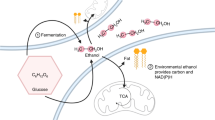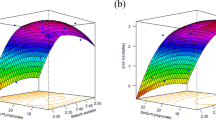Abstract
A PREVIOUS publication from this laboratory1 has reported in detail the rapid oxidation of glycerol to dihydroxyacetone by resting whole cells of A. suboxydans 621, at pH 6.0. This conversion proceeds more slowly beyond the dihydroxyacetone stage. In cell-free extracts with triphenyltetrazolium chloride as the electron acceptor, glycerol is oxidized at a rate comparable to the oxidation of dihydroxyacetone, with the pH optimum about 8.5. This contrasting behaviour has been found to be due to the presence of two major oxidative routes for glycerol oxidation, one phosphorylative, the other independent of phosphate, as shown in Table 1. With cell-free extracts at pH 8.5, adenosine triphosphate is obligatory (in kinase systems) not only for the oxidation of glycerol but also for dihydroxyacetone, glucose, ribose or erythritol.
This is a preview of subscription content, access via your institution
Access options
Subscribe to this journal
Receive 51 print issues and online access
$199.00 per year
only $3.90 per issue
Buy this article
- Purchase on Springer Link
- Instant access to full article PDF
Prices may be subject to local taxes which are calculated during checkout
Similar content being viewed by others
References
King, T. E., and Cheldelin, V. H., J. Bact., 66, 581 (1953).
Horecker, B. L., Brewers Digest, 28, 214 (1953).
Hauge, J. G., King, T. E., and Cheldelin, V. H., Fed. Proc., 13, 225 (1954).
Roe, J. H., J. Biol. Chem., 107, 15 (1934).
King, T. E., and Cheldelin, V. H., J. Biol. Chem., 198, 127 (1952).
Horecker, B. L., Gibbs, M., Klenow, H., and Smyrniotis, P. Z., J. Biol. Chem., 207, 393 (1954).
Axelrod, B., Bandurski, R. S., Greiner, C. M., and Jang, R., J. Biol. Chem., 202, 619 (1953). Gibbs, M., and Horecker, B. L., J. Biol. Chem., 208, 813 (1954).
Racker, E., de la Haba, G., and Leder, I. G., J. Amer. Chem. Soc., 75, 1010 (1953).
Lanning, M. C., and Cohen, S. S., J. Biol. Chem., 207, 193 (1954).
Newburgh, R. W., and Cheldelin, V. H. (unpublished observations).
King, T. E., and Cheldelin, V. H., Biochim. Biophys. Acta, 14, 108 (1954).
Mejbaum, W., Z. physiol. Chem., 258, 117 (1939).
Author information
Authors and Affiliations
Rights and permissions
About this article
Cite this article
HAUGE, J., KING, T. & CHELDELIN, V. Alternate Pathways of Glycerol Oxidation in Acetobacter suboxydans . Nature 174, 1104–1105 (1954). https://doi.org/10.1038/1741104a0
Issue Date:
DOI: https://doi.org/10.1038/1741104a0
Comments
By submitting a comment you agree to abide by our Terms and Community Guidelines. If you find something abusive or that does not comply with our terms or guidelines please flag it as inappropriate.



